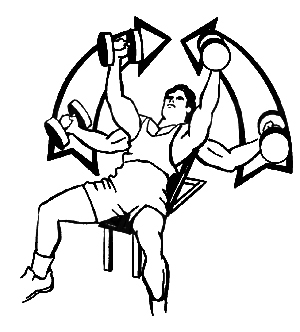 by Dr Paul Batman
by Dr Paul Batman
Client Instruction
Starting Position
- Grasp a dumbbell in each hand and lie on a bench in a supine position
- Anchor your feet so that they are flat and placed firmly on the floor or raised platform
- Contract your abdominals to support your low back
 Down Phase
Down Phase
- Hold the dumbbells directly above your chest in a neutral grip, with your arms almost straight
- From this starting position, inhale and slowly lower the dumbbells towards the floor
- Maintain a relatively fixed straight arm position so that the dumbbells follow a wide arc perpendicular to the bench
- Lower the dumbbells as far as comfortably possible without lifting your shoulders or back off the bench
Up Phase
- Pause at the bottom of the exercise and then return your arms back to the starting position, exhaling as you lift the weight
- As you press the dumbbells above your chest keep your elbows to the side of your body so that they are perpendicular to your trunk
Watch this video for execution instruction
Muscle Analysis
Up Phase
Joint Action Contraction Muscle Group
Shoulder Joint Horizontal adduction Concentric Pectoralis Major & Anterior Deltoid
Down Phase
In the down phase of the exercise the weight is slowly lowered with gravity. The same muscles that concentrically contracted to lift the weight are the same ones that are eccentrically contracting to lower the weight.
General Kinesiological Analysis
In the up phase of the dumbbell fly the shoulder joint horizontally adducts to lift the weight above the chest. This is caused by the concentric contraction of the pectoralis major, anterior deltoid, coracobrachialis and the short head of the biceps brachii. Assisting in lifting the weight is the serratus anterior and pectoralis minor contacting concentrically to abduct the scapula. The elbows are held in a static position by the co-contraction of the triceps and anconeus and the biceps brachii, brachialis, brachioradialis and the pronator teres.
Advanced Kinesiological Analysis
When a dumbbell chest fly is performed, the pectoralis major and the anterior deltoid are the prime movers. The horizontal adduction movement of the shoulder joint is the result of both sections of the pectoralis major contributing to lifting the weight. The coracobrachialis and the biceps brachii contribute to the movement by acting as assistant movers. The con-contraction of the biceps, brachialis, brachioradialis and pronator teres in concert with the triceps and the anconeus maintains the elbows in a static position, which allows the chest muscles to assume full responsibility for the movement. The dumbbell chest fly allows the dumbbell to be lowered to a deeper position than the barbell bench press. Providing the dumbbells are not lowered beyond the chest height, the shoulder joint can be moved through a greater range of motion creating a greater load on the pectoralis major and anterior deltoid.
For the shoulder joint to move into horizontal adduction the scapula must be drawn into abduction, caused by the concentric contraction of the prime movers, serratus anterior and the pectoralis minor.
As the pectoralis major and anterior deltoid are contracting in horizontal adduction they are also causing a secondary medial rotation due to their angle of pull on the humerus. To prevent this from happening the infraspinatus and teres minor statically contract to neutralize this unwanted movement. In the same vein, the serratus anterior and the pectoralis minor combine to cause abduction of the scapula while neutralizing the additional unwanted upward and downward rotation.
In both the barbell bench press and the dumbbell chest fly, the scapula abducts at the same time that the shoulder joint is horizontally adducting in order to lift the weight in the up phase of the exercise. This is an example of dynamic stability, which occurs when the origin of the muscles causing the movement is moving in the same direction as their insertion. The origin of the deltoid is the anterior clavicle, acromion and the spine of the scapula. Its insertion is on the deltoid tuberosity on the humerus. During the barbell bench press and the dumbbell chest fly the anterior deltoid contracts concentrically to cause the humerus to move into horizontal adduction. At the same time, the scapula begins to abduct, moving in the same direction as the humerus.
The stabilizers in this exercise are the abdominals and the spinal extensors.
Variations of both the barbell bench press and dumbbell chest fly have been prescribed to change the angle of the exercise in order to recruit different aspects of the muscles reported. In the incline bench press and the incline dumbbell press the bench angle is changed from a flat position to approximately 15-30 degrees. At this angle there is reportedly a more significant contraction of the clavicular pectoralis major and the anterior deltoid. Below this angle range the full pectoralis major, anterior deltoid and coracobrachialis will contract to cause the movement.
In a decline bench press and decline dumbbell chest press the client’s head is now lowered below their feet to an angle of approximately 20-25 degrees. Its purpose is to create a greater overload on the sternal portion of the pectoralis major. The anterior deltoid will contribute to the exercise.
